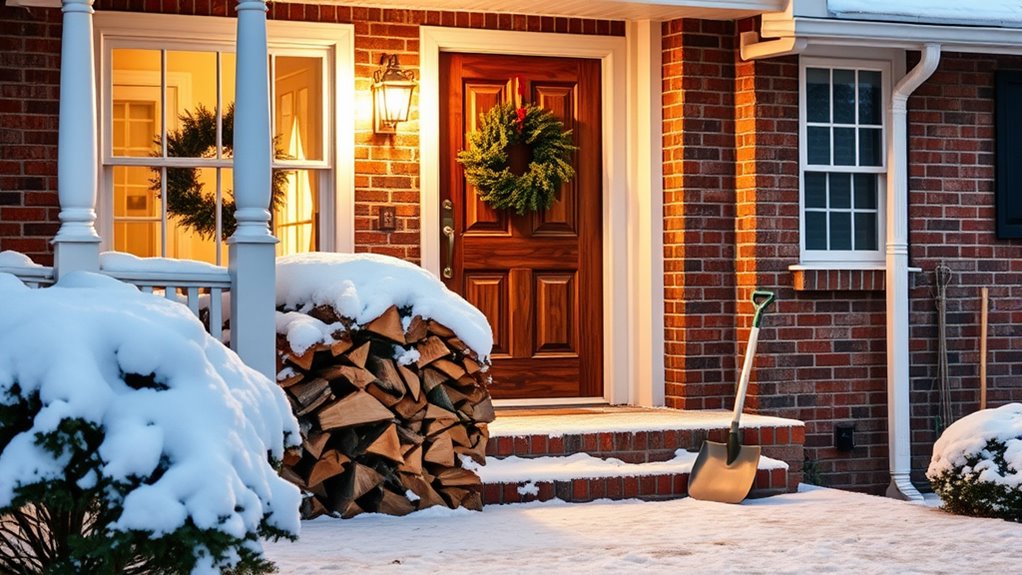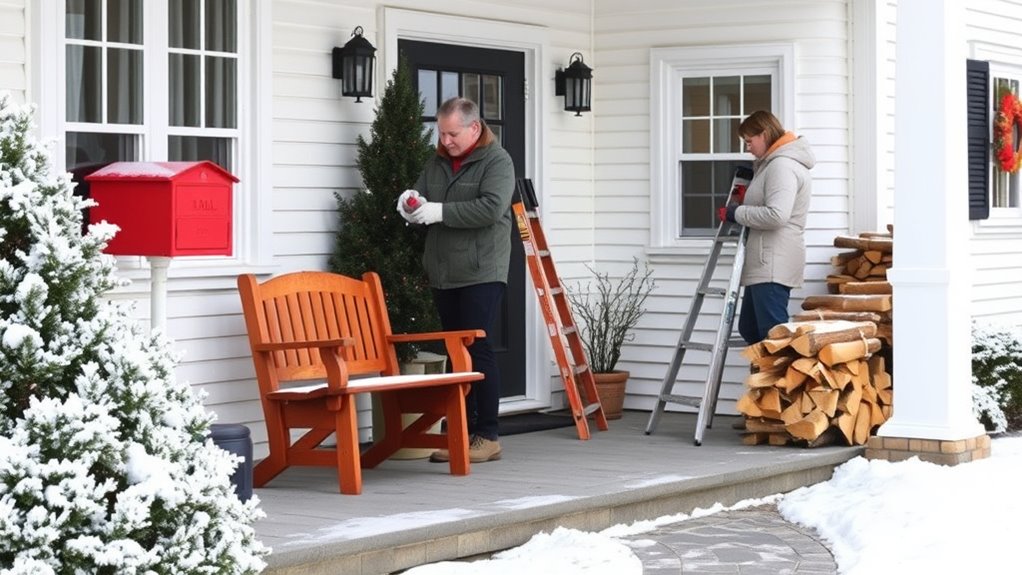To prepare your home for winter 2025, focus on upgrading insulation in your attic, walls, and basement, and seal all gaps around windows and doors to prevent drafts. Schedule a heating system tune-up, replace filters, and consider a programmable thermostat. Clear vents and ensure good airflow, while checking smoke and carbon monoxide detectors. For more tips on staying safe and saving energy, explore the essential maintenance steps to get your home winter-ready.
Key Takeaways
- Schedule professional heating system inspection and maintenance before winter begins.
- Insulate attic, walls, and basement to prevent heat loss and improve energy efficiency.
- Seal gaps around windows, doors, and utility penetrations to minimize drafts.
- Ensure vents, exhaust fans, and air returns are unobstructed for proper airflow.
- Test smoke and carbon monoxide detectors, and check all home safety devices for winter readiness.

Are you ready to tackle your winter home prep for 2025? With colder months approaching, it’s essential to get your home ready to stay warm, safe, and energy-efficient. One of the most effective ways to do this is by focusing on insulation upgrades. Proper insulation keeps the heat inside your home, reducing drafts and lowering energy bills. Check your attic, walls, and basement for areas where insulation may have deteriorated or settled over time. Adding or replacing insulation in these spots can make a significant difference in maintaining a consistent indoor temperature. Don’t forget to seal gaps around windows, doors, and utility penetrations, which can let cold air seep in and cause your heating system to work harder than necessary.
Alongside insulation upgrades, proper heating system maintenance is critical. Your furnace, boiler, or heat pump needs regular checkups to ensure it runs efficiently throughout the winter. Before the cold hits in full force, schedule a professional inspection and tune-up. They can clean or replace filters, check for leaks or blockages, and verify that all components are functioning correctly. A well-maintained heating system not only keeps your home warmer but also reduces the risk of breakdowns when you need heat the most. Make sure to test your thermostat to confirm it’s responding accurately and consider installing a programmable thermostat if you haven’t already. This allows you to optimize energy use by setting lower temperatures when you’re away or asleep, saving money while keeping your house comfortable.
In addition to these core tasks, take a moment to review your home’s ventilation. Proper airflow prevents moisture buildup, which can lead to mold or ice dams on your roof. Clear out vents, exhaust fans, and air returns to ensure they’re unobstructed. Also, consider investing in draft stoppers or weather stripping for doors and windows to further minimize heat loss. Protecting your pipes is another crucial step—insulate exposed plumbing and let faucets drip slightly during extremely cold weather to prevent freezing. To further enhance your home’s efficiency, consider upgrading your windows to better insulate against the cold.
Finally, don’t forget to check your smoke and carbon monoxide detectors. Cold weather often means increased use of heating appliances, which can raise the risk of fire or gas leaks. Test all detectors and replace batteries if needed. By addressing insulation upgrades, maintaining your heating system, and checking safety devices now, you’ll enter winter prepared and confident that your home will stay warm, safe, and energy-efficient throughout the chilly months ahead.
Frequently Asked Questions
When Should I Start Winterizing My Home?
You should start winterizing your home in early fall, ideally by October. Begin by installing storm windows to improve insulation and prevent drafts. Schedule a chimney inspection to guarantee safety and efficiency before heavy use. Check seals around doors and windows, and service your heating system. Starting early gives you ample time to address any issues, so you’re prepared for colder months and avoid last-minute rushes.
How Can I Prevent Frozen Pipes Effectively?
Don’t let your pipes become a ticking time bomb; take action now. Wrap your pipes with pipe insulation, especially those in unheated areas, to keep the cold out. Also, set your water heater to a consistent temperature to prevent freezing. During cold snaps, let faucets drip slightly to keep water flowing. These simple steps help prevent frozen pipes and costly repairs. Stay proactive, and your pipes will thank you.
What Are the Best Ways to Improve Insulation?
To improve insulation, start by installing thermal curtains on your windows to reduce heat loss. Use draft stoppers at door thresholds and window sills to block cold air from seeping in. Additionally, add weatherstripping around doors and windows and consider insulating your attic and walls. These steps help keep your home warmer, save energy, and make winter more comfortable.
How Often Should I Check My Heating System?
Think of your heating system as the heartbeat of your home—you need to listen regularly. You should check it at least once a season, ideally in fall and early winter, to extend its lifespan. Follow a maintenance checklist to catch issues early. Regular inspections keep your system efficient and prevent costly repairs, ensuring warmth flows smoothly through your home when winter’s chill arrives. Don’t wait for a breakdown—stay proactive.
Are There Eco-Friendly Winter Maintenance Options?
Yes, there are eco-friendly winter maintenance options. You can install solar heating systems to reduce reliance on fossil fuels and cut your carbon footprint. Additionally, incorporate composting tips indoors to manage organic waste efficiently during winter months. These options help you stay warm sustainably and reduce environmental impact. Combining solar energy with eco-conscious waste management makes your home more resilient and greener through the colder season.
Conclusion
As winter waves wash in, don’t delay your diligent duties. Double-check your doors, ducts, and drains to dodge damage and discomfort. By preparing proactively, you’ll prevent problems, promote peace, and preserve your property’s pulse. Stay savvy, safeguard your space, and step into the season with confidence. With a little effort now, you’ll weather winter’s worst while welcoming warmer, worry-free days ahead. Prepare properly, protect persistently, and enjoy a peaceful, protected home all season long.










